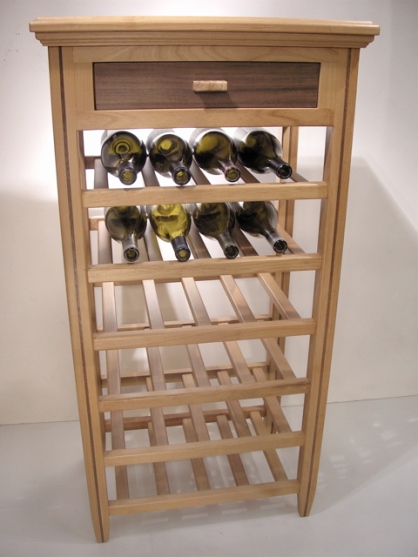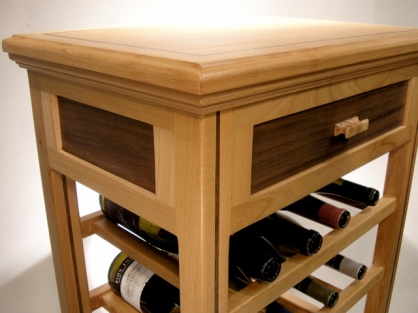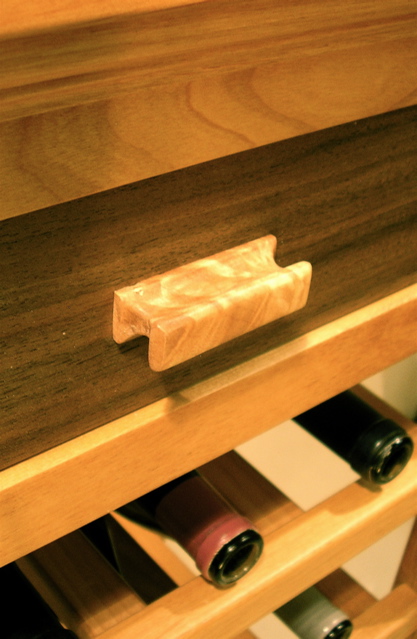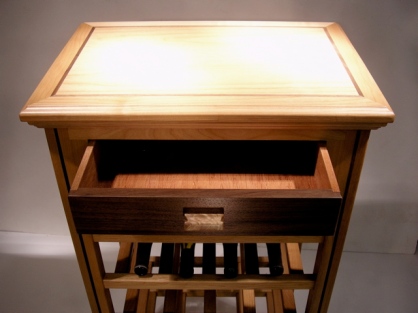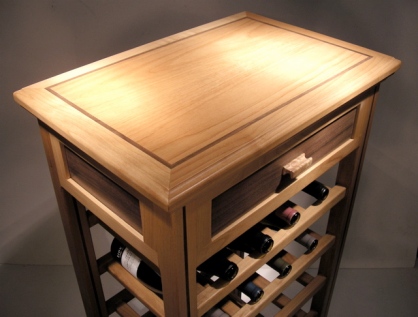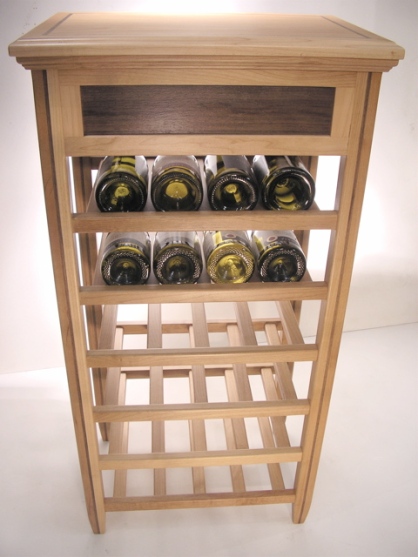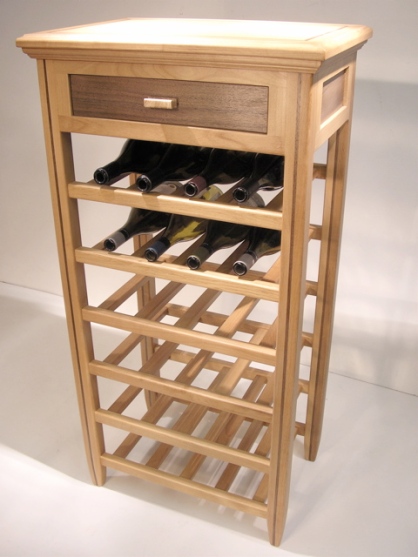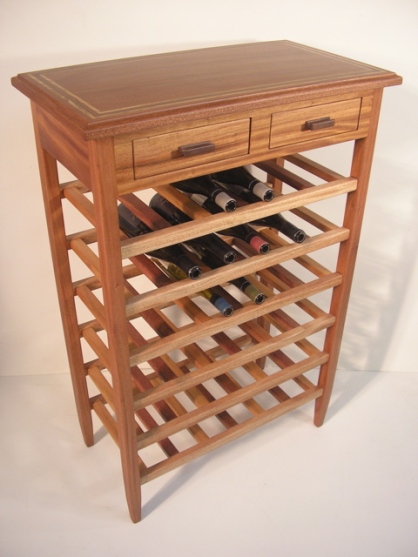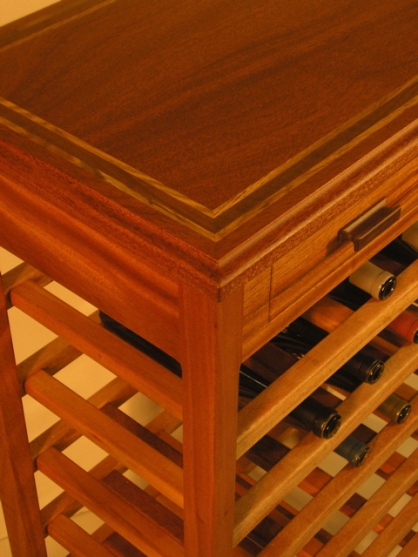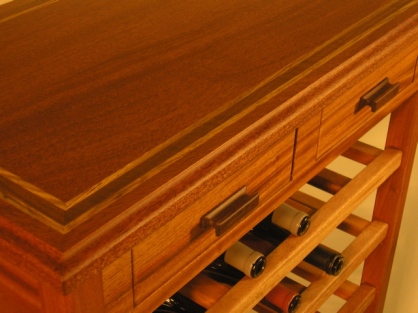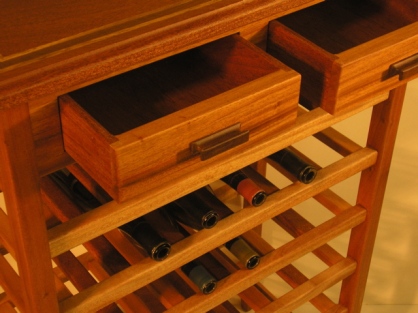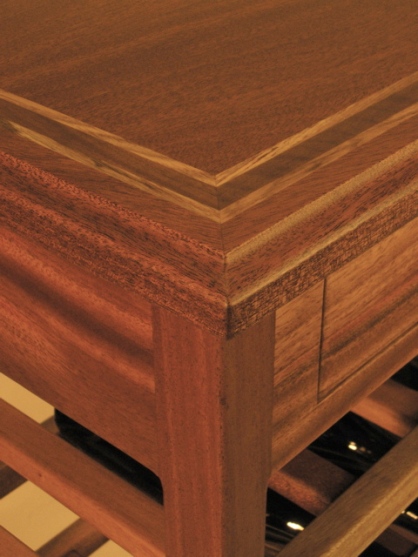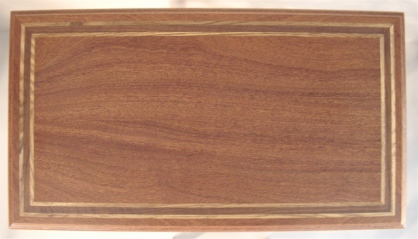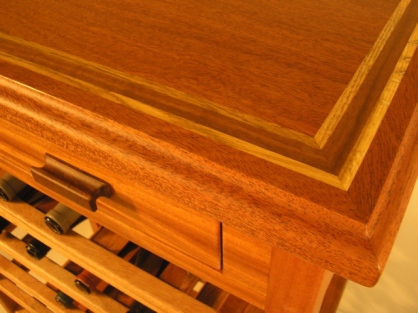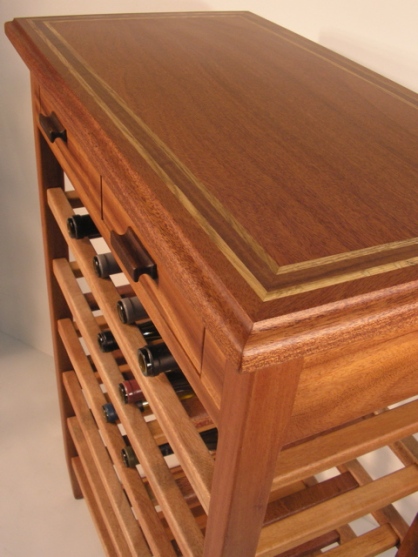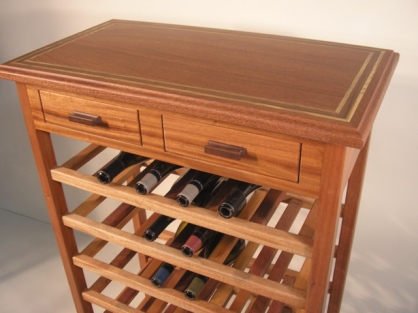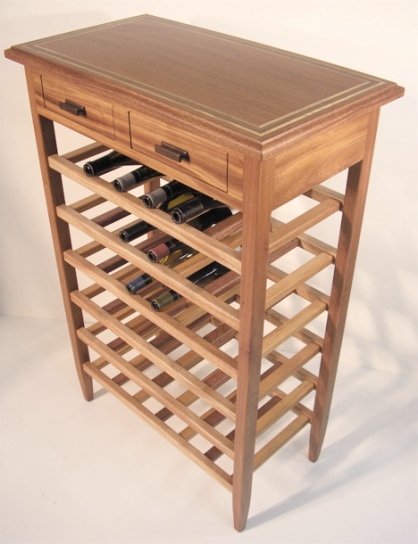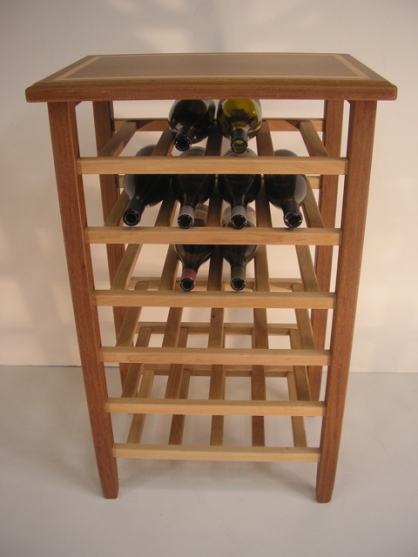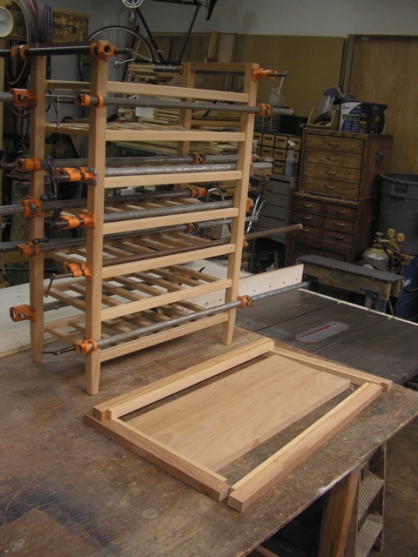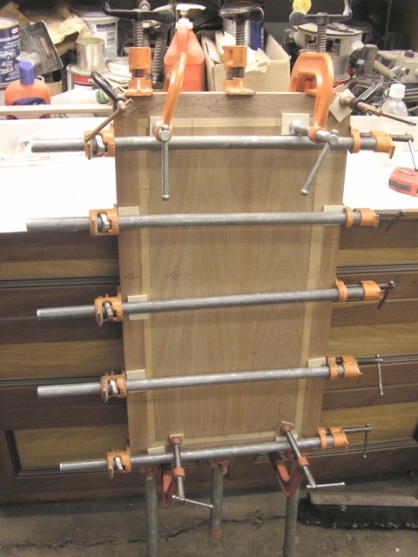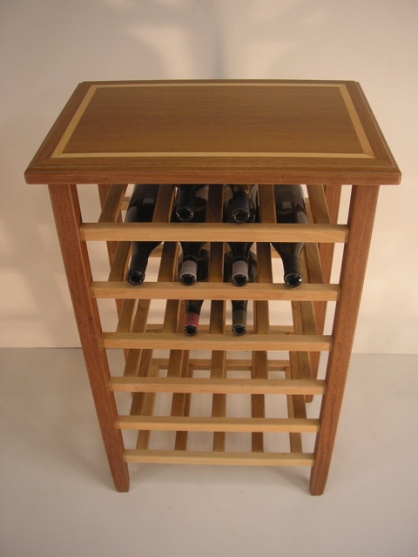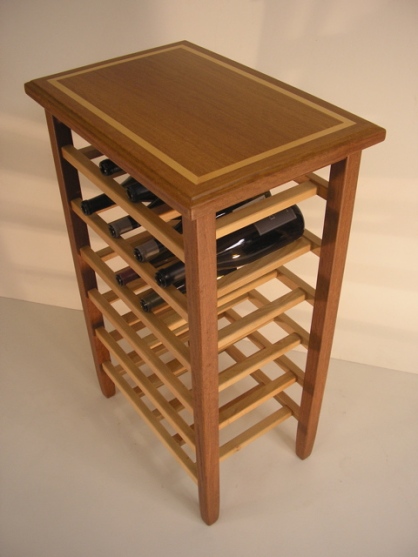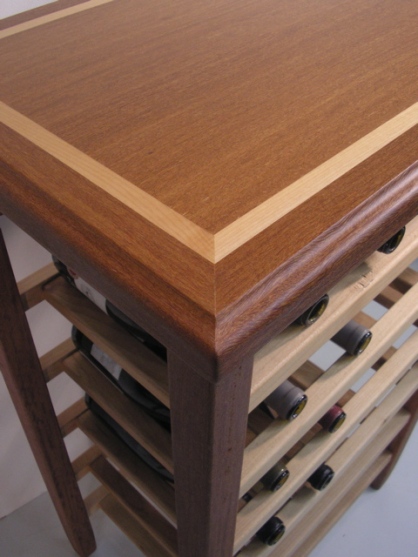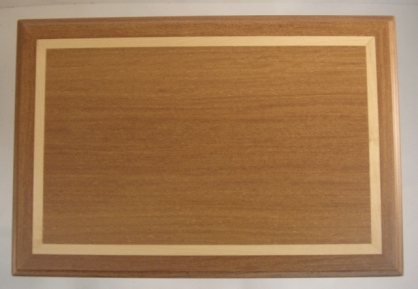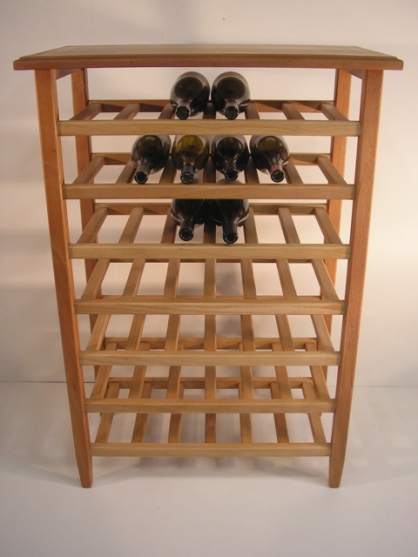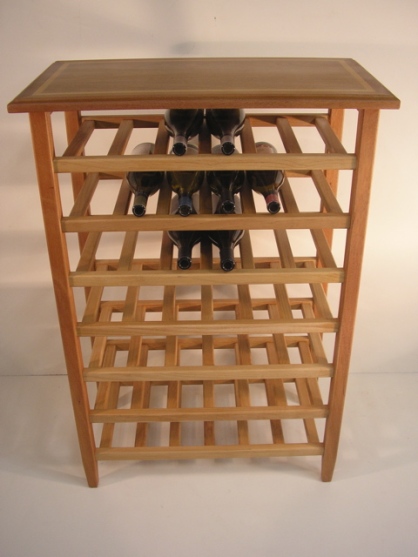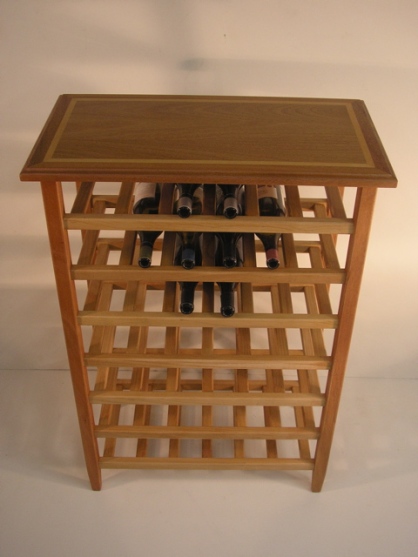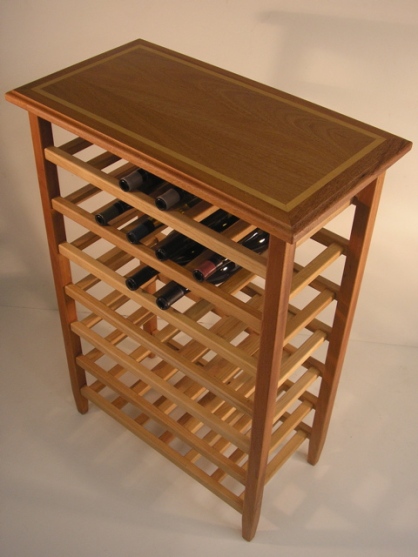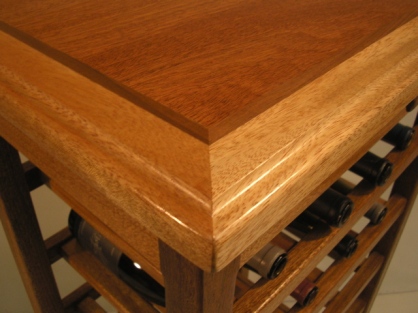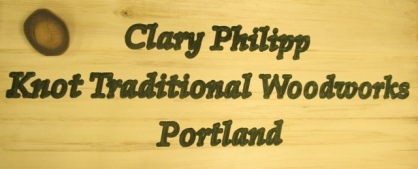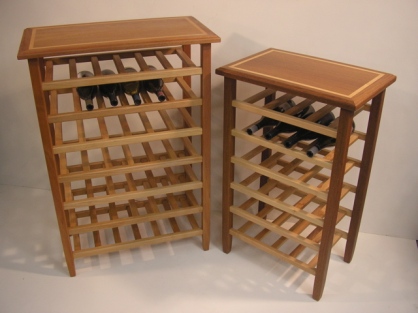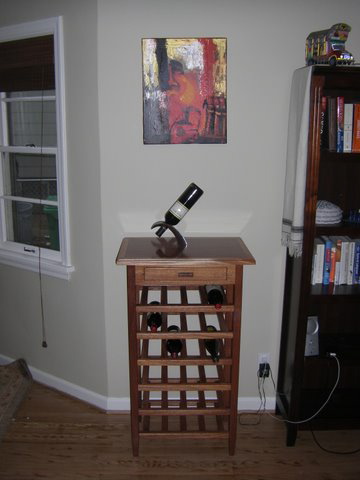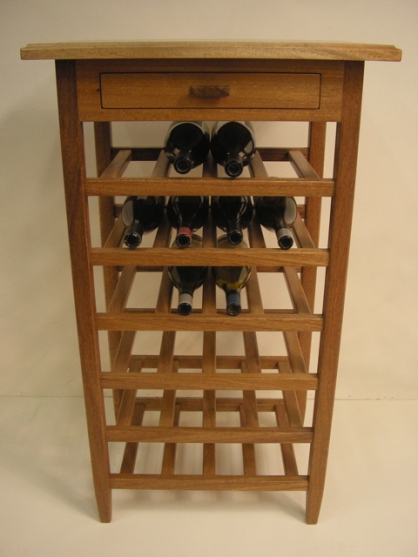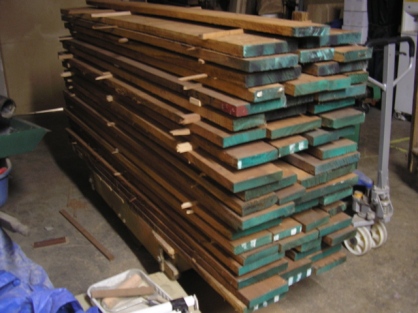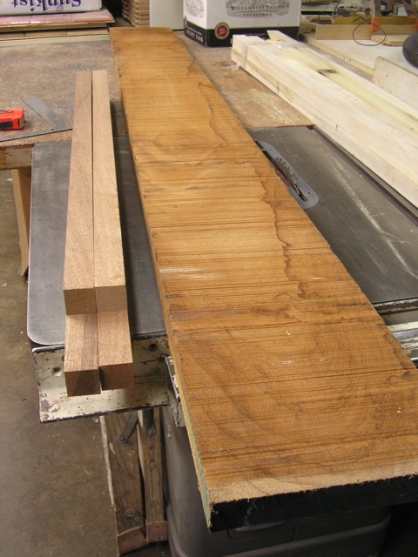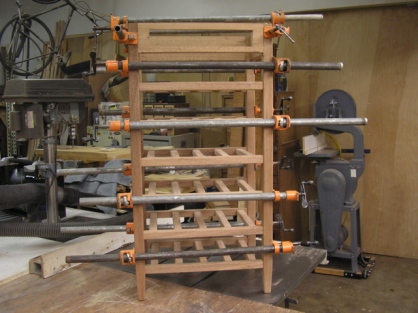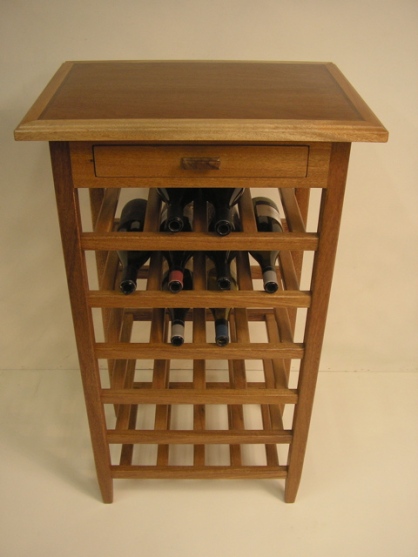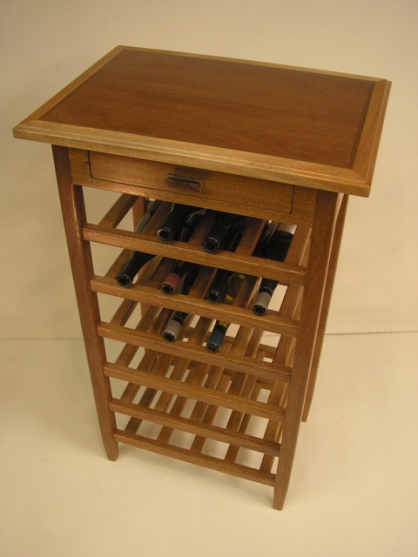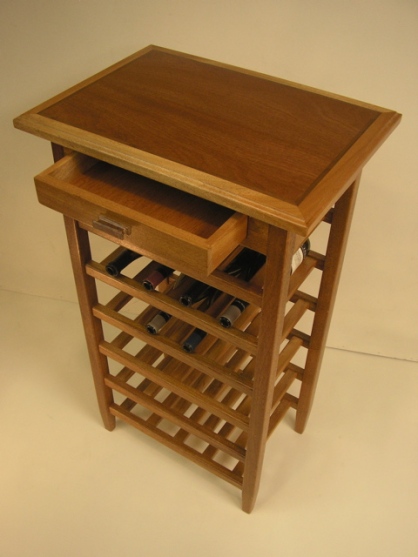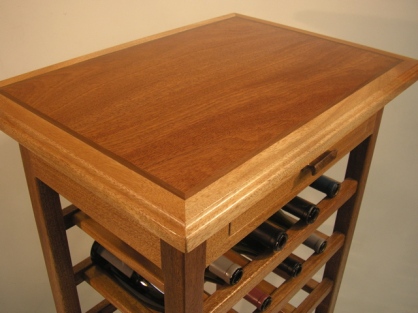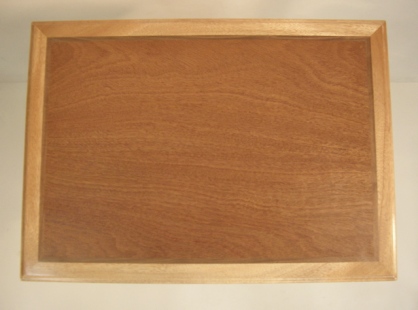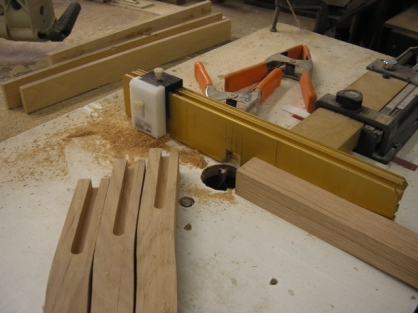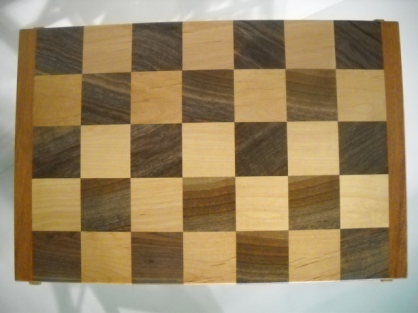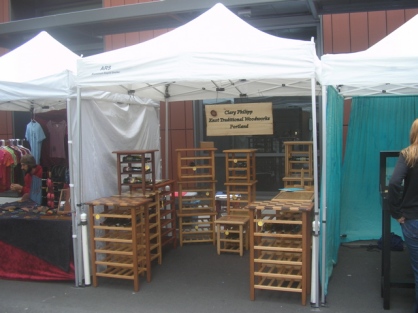Why Wood Wine Racks? Why Knot?
August 9, 2011
Yeah, why would I hand make wood wine racks? It’s not an easy answer… I don’t know… I don’t have a better idea?
I like to work and do stuff with my hands. Woodworking is a cool way to spend time. There are endless opportunities to learn about all kinds of things. A wise man told me that the thing that made it all tick was mystery.
I try to gather up piles of what is other wise wasted scrap material to make something. In this case, I had enough alder to make a taller piece, so I included a drawer and extra cornice molding. I have a few little design motifs that I use somehow on every piece I make. The moulding only works for me on taller pieces and I haven’t included it for a while. The mystery is, what works… what doesn’t? What could I make from this junk?
I do shop drawings and attach cut sheets so I can keep track of parts as I machine material for multiple pieces. Because of the modular nature of my basic design, I can and do change things as pieces get built. It starts with a little voice that asks what would happen if I…??
Some explanation why I make these things could be a kind of fascination with “stuff” and storing your “valuable stuff”. I saw comedian George Carlin way back in the ’60s and he did his famous routine about Stuff. I have always liked jewel boxes, display cases, cabinets that housed collections of stuff.
The real reason is that I read in the paper this week that the Oregon Wine Industry has grown from $500 million five years ago and now contributing $2.6 billion to the economy. The Mystery is how can I get noticed and find a slice of that?
The Ultimate Father’s Day Gift!
May 24, 2011
I have to post some more photographs of KTW#6011. Usually by the time I get a piece into the finishing process I’m already thinking about which one of the projects I have sketched and gathered material for to start next. For some reason this piece really makes me smile when I see it. With the stripes in the grain through the drawer carcase, it looks somehow alive.
I’m not so in love with it that I want it. First of all, I can’t afford to own my stuff. Second of all, I have a cool wine rack that I made from White Oak and Black Walnut a few years ago. It is much like this one with the two drawers, but a little smaller, holding 25 bottles. We have only had it full once. Mostly we only have a few bottles on hand, using the shelves to sort the newspaper and magazines. Then they are available to read when we eat, but can have a place to get that stuff off the table. We are Knot very hardcore drinkers.
I spent so much energy, literally blood, sweat and tears building it, that I can’t see getting enough money to part with it. This wine table on the other hand needs to go to a good home. Hopefully to live it’s life in a beautifully furnished kitchen, dining room or even a wine cellar.
My process is being refined with every piece I construct. I’m getting a lot faster and better all the time.
It still takes me an enormous amount of time to make these racks, and there is an element of risk in each step of the process. I just chopped up a table that has been sitting on a shelf for a few years gathering dust. I got 90% into it and made a mistake that I couldn’t recover from. Whoops.
The most difficult thing for me right now is finding nice material and enough material to make at least one individual piece. So far, so good. This Khaya wood looks so elegant. I have enough to make one more like this. I don’t know what I will do with it. I could save it and use it in contrast with other woods.
I think about design all the time. All kinds of design in all kinds of disciplines and media. Woodworking uses a similar kind vocabulary as playing improvised musics, say straight ahead Jazz or Be-Bop. There may be no lyrics, but still there is a kind of universal transference of feeling and emotion through melody, harmony and rhythm.
Working with hardwoods gives that same kind of opportunity for use as a kind of visual vocabulary. There is a kind of visceral transference of energy that happens too, because at one time these objects were alive and growing.
My hands have touched every single surface of this piece many, many times. In the end, I love being able to touch it and have it feel soft and smooth. I want the drawers to have just the right amount of slide and feel to them. I want to look forward to putting my fingers on the drawer pulls, because they feel right.
I could see this in a beach house or ski cabin, with some nice bottles of red parked there for those weekends that make the years memorable.
Wine Tables, Wine Racks, Made In Oregon!
May 2, 2011
This rack was made from Machiche a very dense, hard, tropical lumber from Central America (sometime called Black cabbage-bark). The racks and feature strips in the mitered edge band on the tops is Alder from Oregon.
The dimensions are 23 1/2″ wide, 15 1/2″ deep and 37″ tall. The field here for the top was assembled from a piece of lumber that was cross-cut in two and folded back on itself. The edge band was cut from the same board so the color would remain consistent.
This Machiche is very hard and seems kind of brittle too, but it also seems dimensionally stable, resistant to expansion and contraction due to changing moisture in the air.
The grain is very beautiful. It’s subtle because at a distance it just seems to have a rich dark color, but up close the grain has a wonderful curly pattern.
The top turned out great. The glue joint is virtually invisible. It’s so cool when things turn out better or different from the way I envisioned them. I think the contrast with the light Alder wood turned out great. I love it when wood seems to have a golden glow to it.
I try as hard as I can to make each piece as well as I can. But still I make small mistakes and I’m working wood with it’s own challenges. No matter how much time or effort I put forth, things are never perfect, so I just do my best, work as quickly as I can, and try to get my kicks making different stuff from what ever material comes my way.
I always expect things to go wrong, because they already have so many times throughout each step of the process. Sometimes, I walk into the shop the morning after applying the final coat of clear finish the night before, and look at my pieces with kind of a detached amazement. Then it all comes back to me… oh yeah that was some idea I had way last month. I looked at some boards and thought I should see what would happen if I did this or that.
It’s great when I can think to myself… that turned out pretty good. So now, #0511 needs a good home and worthy bottles of wine to proudly display!
Wine Racks-Custom Designs-Made In USA
April 29, 2011
Six bottles wide by seven racks high, gives you a 42 bottle capacity. Notice how even the fat Champagne style bottles that many wineries are using for their Pinots fit without touching.
This legs and top of this rack was constructed out of Khaya also known as African Mahogany. The racks and contrasting feature strip laminated into the top are Oregon Alder hardwood.
It is 40″ tall, 28 1/2″ wide and 15 1/2″ deep.
I apply three coats of poly-urethane that is virtually water proof and very stain resistant. I use a satin sheen that brings out the natural color and grain of the lumber, imparts a velvety smooth feel, and gives that hand-rubbed antique effect.
I’m surprised that through the whole stack of boards my neighbor Lavrens passed on to me, each piece has very different shades in the color, but yet has the same grain characteristics.
If you are a serious wine enthusiasts, you probably buy bottles a little too expensive or too many bottles that were a deal that couldn’t be passed up. You could treat yourself to a nice hand made rack like this to stash your treasures!
Custom Wine Racks in Portland Oregon
April 26, 2011
6 x 7 = 42 and 4 x 6 = 24 bottle capacity racks. #4 on the left is Khaya African Mahogany and #5 is Machiche, a very dense hard tropical lumber from Central America (sometime called Black cabbage-bark). The racks and feature strips in the mitered edge band on the tops is Alder from Oregon.
I got a message right after my last posting and so KTW #0311 has found a good home. Thanks for the support Pete… and for sending me photos!
I have some interesting wine rack projects going on and I’m starting to think about slicing up a few logs that have been drying for more than a year in the back corner of the shop . More to come, stay tuned…
Free and Knot Free Wine Racks…
March 26, 2011
Lavrens, my neighbor at the shop, came through for me again. He has a buddy who works or worked for a Canadian lumber wholesaler. A few years ago when the economy was still functioning, they bought units of exotic lumber to sell to high-end users. As the economy was destroyed, they went back to selling construction grade lumber and plywood. That didn’t work either so they closed the warehouse.
When they cleaned out the building, this unit of lumber was not in the inventory, so Lavren’s friend gave it to him, and he gave some to me. It is an African Mahogany called Khaya Ivorensis or commonly Khaya.
I cut one of the pallet skids in quarters for some legs. I was impressed by beauty of the grain and the color. It is fairly hard and dense. I don’t like the way the sawdust smells. It is a little acrid, but not horrible like Ipe, and certainly not as nice as real Honduras Mahogany.
These must have been some big trees because it appears like all heart wood. It mills up straight and true with no warping or cupping. Nice to work with and easy to machine.
Since I had quite a lot of material to choose from, I decided to make a piece that is narrow and a little taller. It holds 24 bottles and has a drawer for cork screws, stoppers and wine glass charms. 23 1/2″ wide x 16 3/4″ deep X 40″ tall.
The top turned out great. I planed a piece, crosscut it, then joined it back on itself for the field. You can barely see the joint.
I used Oregon Black Walnut for the feature strip and drawer pull.
The edge band was from a different piece of lumber. It’s pretty amazing how different the colors turned out from piece to piece. After I sanded everything off, the colors seem rather uniform. The urethane I use made the grain and true colors pop out.
While the grain and figure from piece to piece is very uniform, look how different the legs are compared to the carcase, and the edge band against the field on the top.
Like I said, free from any knots… and my favorite type of wood too… free. Thanks Lavrens!
Knot normally the way I do it…
February 10, 2011
A lady saw photos of a wine rack I posted for sale on craigslist and contacted me. I invited her to the shop to see what different pieces I have in my inventory. She had a corner in her dining room where she wanted to place it and we discussed dimensions.
She looked at completed racks and I explained how the modular nature effected the over all dimensions. She gravitated to a piece that was constructed from Black Walnut and Sapele, and said she really liked the redish color of the Sapele… also know as African Mahogany. She ask what color of stain I used.
I had to laugh and said that there was no stain, I use different hardwoods to show off their natural color. There is no reason to use a stain. I do however use stains on the pieces I make out of soft wood like Pine, Fir or Cedar. I showed her a couple of those different pieces and some raw wood to illustrate how washed out the natural wood looks generally. She wanted, if not to match, at least compliment her dining room table.
She ask how much the Walnut/Sapele piece was and I said it was three times as expensive as the Fir/Pine ones. It was too small for her but she really liked it. I had to laugh again. I said, you have good taste, your like my wife. She sees a red car and says, wow that is a beautiful car, I want one of those. I say, baby you have good taste… that is a Ferarri. How about that red car over there? No, I don’t like that so much. Well Babe, that’s a Toyota.
I had three racks made from Alder that were recently glued up but I had not made tops for yet. They were the right dimension and bottle capacity for her. I showed her the two most common tops I make… Mitered edge band, with or without a contrasting feature strip, and the Breadboard style with through tenon joint.
She liked the Breadboard style, saying that the way I leave the tenon protruding matched her table’s styling. I told her that I never stain hardwoods, but that furniture manufacturers routinely apply stains to Alder. I pulled out my drawer full of sample stain cans and proceeded to wipe stain on some Alder scraps. The first one or two colors were spot on for her. So I made a Breadboard top, stained the piece and applied three coats of polyurethane.
She picked it up yesterday and said it looked great. As much as I would love to be purist, use highly figured exotic woods and tradition oil and wax finishes… I’m not a snob. In the real world, it’s only other woodworkers that really know the difference between a Ferrari and a Toyota… or care. While it’s Knot normally how I do things, it pays the bills. I did like the way it turned out and more importantly so did she. Thanks for the support… another one goes to a good home.
Knot How It’s Supposed To Work…
November 22, 2010
It can start with a need. In this case, a friend has been remodeling his house and needed to put a key in a door at the end of a hall. All he told me was that he wanted a table to put a lamp on, so he could see the door knob, and that the space in the corner of the hall was 10″ by not more than 18″.
I like to have some kind of symmetry in my designs and the one dimension that seemed fixed was the 10″. Quickly I thought, how about 10″ deep by 15″ wide and 30″ tall… multiples of five.
I looked through my piles of wood and lumber for some walnut but didn’t really find anything that jumped out at me. I uncovered some gnarly pieces of Red Oak that my friend had given me last year and I’d completely forgotten about. I planed off the sides to see some nicely figured pieces.
They were just 29″ long, perfect legs for a 30″ table height. I squared them up on the jointer and thickness planed them. There were a few defects, checks, splits and splintery grain. I also thought because the piece was pretty small, I needed to cut them down so they would make sense within the scale of the piece. Hopefully I could cut out the defects too.
I fooled around with a bent piece of quarter round moulding that I use with a string to adjust the bow for marking curves. My idea was to make curved legs and cut out the defects. I cut a piece of plywood the size of the leg blanks for a template.
The hardest thing to do was figure out the sequence of cuts so I’d have a flat surface to run the against the fence and get a square part with which to join the carcase. Here is the first cut…
…then flip it 90 degrees for the second cut, and still have a flat surface to run against the table.
Legs.
That was the end of the day. I had a few random pieces of Red Oak in my stash but not enough to do much. I left the shop that night about eleven thirty in a driving rain. I got to the end of block where there is a new and used resteraunt supply business. They always have stacks of pallets and cardboard set out for the recyclers. There was an Oak counter with white melamine top and shelves sitting in the rain. I got out, kicked the particle board sides and top off it, and stuck these nice raised panels in the truck,
Nice stash of free material, except that when I cut them apart, the panels had been run through a sander or planer and were only 9/16″ thick. Couldn’t use them for a top like I hoped. Oh well, the styles and rails were still 13/16″, so I cut them up. I couldn’t use the panels, so I rummaged around and came up with this…
 … a piece of Goncalo Alves that one of my shop neighbors gave me. It was an
… a piece of Goncalo Alves that one of my shop neighbors gave me. It was an
off cut from a big board he used to make cabinet doors.Next I laminated pieces of
the Red Oak from the styles and rails on the salvaged counter and laminated
Black Walnut for the feature strips in my new top.
Next, I miter the edge band and…
… and glue the top together. Next I made the carcase sides, cut out the drawer front.
I make the pieces a little wider than I want, so I can rip the drawer front out and glue the frame back together. The you see the grain pattern run through the piece. At least that’s the idea. Next I machine the tenons for joining to the legs.
Next I machine the mortices in the legs on my router table equipped with an IPM fence. Same deal, it was harder to figure out the sequence of cuts, so I had a flat surface to run against the table and fence, than it was to machine the parts.
The IPM machine allows me to make extremely tight fitting joints. I have to make them at least sloppy enough, so that when they get wet with glue, they slide together and won’t wipe the glue off the joint or have to force it together. Every click of the detent wheel moves the fence a thousandth of an inch.
I sand all my parts then glue up. Unfortunately, in my haste to get everything square and true, I flipped the front backwards and by the time I realized it, I couldn’t pull it apart again, the glue dries that fast.
I know and you know, but nobody else will every know. I make runners that fully house the drawer, so I can have tight fitting drawers that slide smoothly and positively. I should have dovetailed the drawer sides, but once I have made a mistake that I can’t or don’t want to spend the time recovering from, I just want to finish and see if the overall design works for me. Still, I make traditional box joints to hide the dado for the drawer bottom.
The drawer bottom was a scrap of Jatoba. I looked through a big box of my signature drawer pulls. It took me years to come up with pulls that felt good in your fingers when you open the drawers. I make them by the dozens because it takes six router setups to create them. I don’t want to stop and make one in the
middle of a piece.
Unfortunately, I used all The Red Oak pulls on a previous table,
but at the bottom of the box was one I made from Spalted Apple. Here I route a
mortice in the drawer front to accept a tenon on the back of the pull. A perfect
color match!
Finally I put it all together, did some finish sanding and applied three coats of a
water based lacquer.
When I showed it to my friend, he told me his father had worked at a millwork company in Tigard, Oregon for thirty years and that the pieces he had given me, were rejected turning blanks he brought home to burn forty years ago. My only cash outlay was for the Lacquer.
I was disappointed that I didn’t get the grain to run through the front of the carcase, but I like the way the legs came out. I’ll put them in my repertoire and do better next time… maybe in Black Walnut.
My friend really like the piece and thought it was better that he envisioned.
Wine Enthusiasts Christmas Gifts…
October 26, 2010
What to get the wine connoisseur or alcoholic wino for Christmas? How about a counter top wine rack?
Gen-u-wine Knot Traditional Woodworks wine racks. Produced from local FAS Kiln Dried Alder lumber. (The Forest Stewardship Council is creating sustainable forests worldwide, producing and certifying sustainable lumber for a growing industry of green builders.) The through tenons in the bread board style tops are made from Oregon Black Walnut logs I have dried and milled.
Further more, I machine parts and hand assemble these wine racks from rips and off cuts, gleaned from the custom upholstered furniture business next door. If I didn’t take it, they would burn it or put in in the dumpster.
I apply three coats of bar top poly-urethane that is stain resistant and virtually water proof. I use a flat sheen so that you can see the natural color of the wood and the grain, not a glossy wet looking finish.
Because my design is modular, I can make four bottle, six bottle and eight bottle racks, that will fit on a counter top or sideboard. I can build them with my miterd tops too… like this four bottle by two shelf model.
Again, Alder hardwood with Oregon Black Walnut for the feature strip in the top.
So many combinations and ways to construct these wine racks. I have some really interesting harwood logs that are drying but not ready to make parts out of yet. I would like to make these from Black Walnut or White Oak eventually too.
If you have some floor space, maybe a unique 36″ tall (counter top height), 20 bottle rack to display your collected wine treasures.
The checker board top for this piece was made from some kind of fruit wood, probably apple, for the light squares and Black Walnut.
These legs were milled from a very heavy, hard, dense, tropical wood that a friend of a friend got for me. He works for a lumber importer that was doing inventory and found these big planks buried under dust and debris for years. When they couldn’t identify the planks, didn’t know where they came from, I fortunately ended up with them.
The bread board ends are Sapele, the through tenons are Australian Lacewood and the shelf racks are Alder.
I cut out three of these racks, but only had enough material for two tops, so someday I will come across some nice lumber and make a different top on legs and shelves like these.
The top for this piece I made from Alder for the light squares and highly figured Balck Walnut for the dark squares.
As much as I try make these in a production fashion, it’s still mostly one offs or two offs like these examples.
I tried to cut boards so that the dark figured grain pattern looks like it runs through lighter squares. My photographs don’t really do it justice.
About the time I get pieces ready to apply a sprayed on finish, I’m already thinking about ways to put the next ones together. There is still time to make some special presents. What is next?
Making Something Out of Nothing. What’s Next?
September 30, 2010
A friend of mine used to say that if there was and easy way, or a hard way, to do something… I will always choose the hard way.
Last fall I decided to try being a vendor at the Portland Saturday Market. Partly just to see if I could actually sell my products, but partly to get feedback about the whole wine rack idea, examples of my design ideas and craftsmanship. I told myself I would give it a year to see how the Market could work for me. If I didn’t try, I wouldn’t really know how it worked.
Above: A piece of fire wood I pulled from a stack. It’s some kind of fruit wood, maybe Apple, but could be from a Plum or Pear tree. Below: I cut some highly figured pieces of Black Walnut, this Apple log and contrasting pieces of Alder. then I cut a tongue and groove with my IPM Machine on a router table with up-cut solid carbide spiral bit.
The red and blue crayon marks are to tell me to route either a tongue or groove.
I tried to organize the pieces so that the grain pattern continues in order through contrasting light/dark pattern.
This experiment in joinery has one more row than the first top I made two months ago. People seeing this first wine rack top said, “Look Honey, we could play chess and drink wine!” I hadn’t even thought of that in terms of it’s graphic representation. I was just trying to make a big top out of small scraps of wood. This time around I added another row to make it look more like a real chess/checker board. I would need two additional rows to actually play a game on it, but this time it looks more like a game board. Because the tops are rectangular, the “squares” wouldn’t turn out square.
It is very time-consuming and tedious to machine parts and glue this up. Adding two more rows so it was a real game board would just add more work.
I still might try it some day but I need to drop back and punt as they say. For me the game is to design things around “FREE” material. It would be too easy to design beautiful, complicated woodworking ideas and just go to the lumber yard and buy expensive, highly figured exotic materials. In the end, I still need to sell them. That is the trick.
One of my neighbors at the shop gave me a two huge planks of some kind of tropical hardwood. He got it from a friend that works at a big wholesale lumber importer. In an inventory they found three big planks covered in dust at the back of the warehouse. Not knowing where the lumber came from or what it was, the friend gave it to my neighbor, who after a while had no use for it. So, it came to me. It is very hard, heavy and dense beautiful material. I used it for legs and rather than cut up big pieces of material, I used off-cuts and rips of Alder wood from my furniture building neighbors to make the racks.
It was a beautiful warm summer Saturday and the Market was pretty packed. Just as I hoped, hundreds of people were sucked into my little experiment! I can’t say it enough… If I had a nickel for every person that rubbed the tops, I wouldn’t have to sell them!!! Literally hundreds of people stopped to look at these two pieces and tell me that my craftsmanship was like art work. Great, just what I don’t need to hear anymore.
Above: You can see my first “checker board” top in the back. In close to three months, I still haven’t been able to sell it. Despite being told repeatedly that my prices were “very reasonable” or “too cheap”. I chopped fifty bucks off the price of it this day and still didn’t sell it! I tagged the two new pieces at $175 and reduced the prices of everything else at least $25. Very few folks looked at my other pieces or the checker topped piece in back for $125. I handed out a huge stack of business cards, flyers and talked to more people than I can remember about building them custom racks. Not only did I not sell one thing all day, but I never got a single call or e-mail for custom work.
Above: Traditionally styled bread board ends made from Sapele, and the through tenons are Australian Lacewood.
So, I’m coming up on one year of doing the Portland Saturday Market. What have I learned? Expensive lessons:
#1 The only people who are making money at the PSM is the PSM.
#2 Most of the PSM vendors are barely scraping by and many of vendors I talk to are going to quit.
#3 The public comes to the Portland Saturday Market just for cheap entertainment and the social hang out, not to actually buy anything. The economy in Portland is destroyed. If anybody has a job or any money… they ain’t spending it!!
#4 The people who run the Market have a hard task in trying to deal with a City hall and other public agencies that don’t really care to help the Market out. The Vendors who should care about the future of the Market and Market policy, don’t care at all. Having attended the last two membership members meetings with maybe twenty of the same long time vendors in attendance, and the three or four hundred vendors that show up each week conspicuously absent… apathetic would be a good description.
#5 If participation in the market, got my name/brand out there and worked as an advertising tool, it might be worth paying the monthly membership fee, daily booth fees. But to work all week, then get up early Saturday, set up the booth stand there all day, then pack up and go home for a twelve-hour day after not selling one thing to cover the cost of gas and lunch… I must be insane!
#6 I can’t afford to do the Market any more. The half-assed good Market days I had were off set by three bad days. It doesn’t look like this is the right venue for my endeavour. The PSM organizers don’t really care about me or most of the vendors for that matter. They know that there is no shortage of broke, laid off, out of unemployment insurance fools, that will give the direct marketing thing a shot.
The decision whether I should try to continue doing the Market is made for me. It’s not working for me anyway I slice it. I’m sure that there are other things I can try or do… but what ever it is, it needs to be easier.
Onward…
